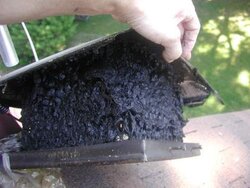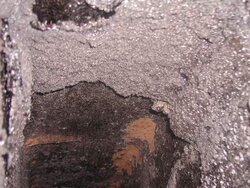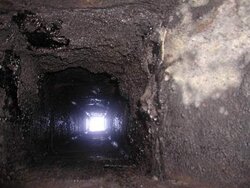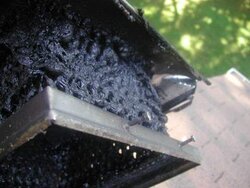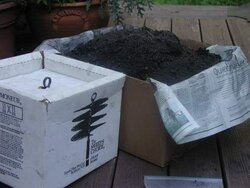This is a message I posted earlier at https://www.hearth.com/econtent/index.php/forums/viewthread/45292/#496547 that I thought I would start a new thread with the pics:
I have a lot of experience burning a large cat stove 24/7. A lot of overnight or “gone to work” packed firebox at 500F, with the air turned down, which slowly drops to a low fire. Over the years, I was surprised at how little creosote I got in my chimney cleaning. I was also using an exterior chimney, 11 x 11, 24’ high, with a direct connect that just dumped the smoke above the smoke damper and shelve. The stove had a 8” flue and when I installed it, I knew that it was on the margin in terms of having too much cross section in the chimney. I would usually get about a half a bag (paper grocery bag) of creosote on my annual cleaning. I burned between 2 and 3 cords/year. Usually OK seasoned oak, but sometimes it steamed alittle (less than fully dry). I sure I got a lot more creosote than folks with insulated chimney liners, but less than I expected. I did not think I was endanger of a chimney fire. So was fairly amazed that I did not get more creosote, and it made me a little cavalier about being careful about creosote.
Last winter, early Feb, my 18 year old cat, which was fraying in spots, totally crumbled. I don’t think it was working very well most of the winter. I continued to burn for another month with out the cat. When I went to clean the chimney, burning without a cat, with my setup, and the way I burned, was much riskier than I realized. I had major creosote build up. The chimney cap was getting close to closing up with creosote coating the bird screen mesh. I got almost 2 cubic feet of creosote out with my brushing. (Pics to follow). My lesson is that the cat secondary burning is very important to the first and middle part of a burn. Even though the later part of the burn, the cat loses enough temp to be effective, as someone noted, it is in the charcoal stage, so it is not a major producer of creosote.
I now have a full chimney liner, insulated with a good rockwool kit, full block off plates at the top and bottom, and I am burning a non-cat Jotul Olso F 500. Also, I am hoping to be more careful with my wood, burnig better seasoned wood, but probably not super dry. I’ll let you know my comparison of creosote after I do my cleaning. I probably will do a mid winter cleaning to be safe.
[Pictures show what can lead to a chimney fire. Ignorance is no excuse]
I know the cat’s supposed to take care of a lot of it but that’s only when it’s engaged so I figured there would likely be 2-4 hrs (or so) on the back end of those long, long burns where a lot of creosote could form? Or, have you found they’re both (cat & non-cat) about the same irt creosote because by the time they both begin cooling down the wood is burned to the point that there isn’t much soot creation in either type? Anyone with experiences using both types irt creosote?
I have a lot of experience burning a large cat stove 24/7. A lot of overnight or “gone to work” packed firebox at 500F, with the air turned down, which slowly drops to a low fire. Over the years, I was surprised at how little creosote I got in my chimney cleaning. I was also using an exterior chimney, 11 x 11, 24’ high, with a direct connect that just dumped the smoke above the smoke damper and shelve. The stove had a 8” flue and when I installed it, I knew that it was on the margin in terms of having too much cross section in the chimney. I would usually get about a half a bag (paper grocery bag) of creosote on my annual cleaning. I burned between 2 and 3 cords/year. Usually OK seasoned oak, but sometimes it steamed alittle (less than fully dry). I sure I got a lot more creosote than folks with insulated chimney liners, but less than I expected. I did not think I was endanger of a chimney fire. So was fairly amazed that I did not get more creosote, and it made me a little cavalier about being careful about creosote.
Last winter, early Feb, my 18 year old cat, which was fraying in spots, totally crumbled. I don’t think it was working very well most of the winter. I continued to burn for another month with out the cat. When I went to clean the chimney, burning without a cat, with my setup, and the way I burned, was much riskier than I realized. I had major creosote build up. The chimney cap was getting close to closing up with creosote coating the bird screen mesh. I got almost 2 cubic feet of creosote out with my brushing. (Pics to follow). My lesson is that the cat secondary burning is very important to the first and middle part of a burn. Even though the later part of the burn, the cat loses enough temp to be effective, as someone noted, it is in the charcoal stage, so it is not a major producer of creosote.
I now have a full chimney liner, insulated with a good rockwool kit, full block off plates at the top and bottom, and I am burning a non-cat Jotul Olso F 500. Also, I am hoping to be more careful with my wood, burnig better seasoned wood, but probably not super dry. I’ll let you know my comparison of creosote after I do my cleaning. I probably will do a mid winter cleaning to be safe.
[Pictures show what can lead to a chimney fire. Ignorance is no excuse]


